According to Cognitive Market Research, the global mobile market size exceeded USD 818.2 billion in 2025. This fascinating number is justified by the fact that mobile products have already become core drivers of customer engagement, revenue growth, and game-changing insights. While 92% of G2000 companies use IT outsourcing, according to Exploding Topics, the combination of mobile projects and external specialists is an obvious winning strategy when done right.
As the mobile application development outsourcing evolves, the performance and UI of an app still matter, but an innovation-driven development approach closely aligned with business goals is a key factor to success.
In this guide, we will explore how to define business goals and functional requirements, evaluate potential partners, choose the right engagement model, and structure communication to ensure transparency and alignment. You’ll also learn how to maintain high product quality post-launch through continuous delivery, monitoring, and iterative improvements when outsourcing mobile app development.
Why Companies Outsource Mobile App Development
Mobile ecosystems have become more complex than ever before, so organizations need to adjust the way they build and scale digital products. It makes outsourcing a strategic approach that helps to implement innovation, spend resources wisely, and unlock sustainable growth. Below are main reasons why companies choose to outsource mobile app development in 2026.
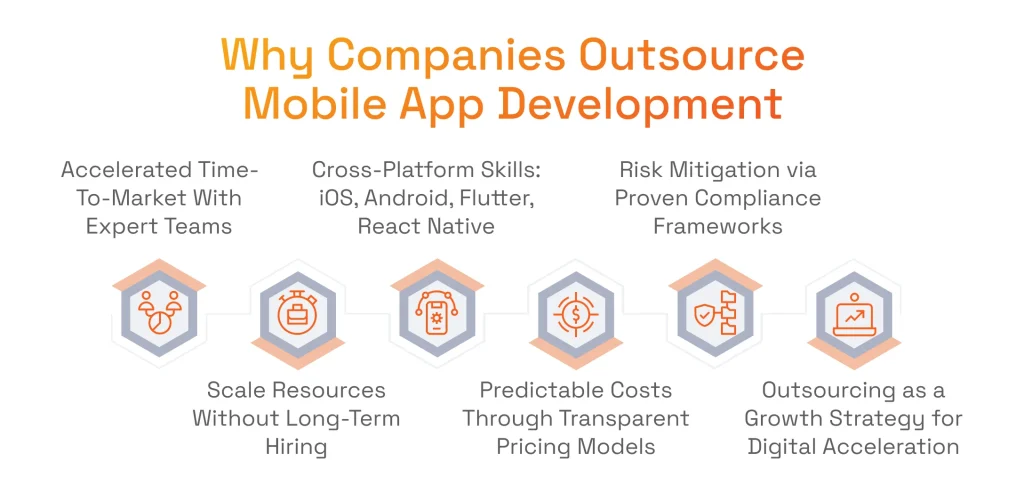
Accelerated Time-to-Market and Access to Specialized Skills
Outsourcing vendors bring immediate access to senior engineers, refined delivery workflows, and a structured approach, often formalized through a Service Level Agreement for product development. These SLAs clarify performance expectations, response times, and quality benchmarks, creating predictable conditions for continuous delivery. This level of operational maturity allows companies to launch faster, iterate more efficiently, and respond to user feedback with agility.
Ability to Scale Resources Without Long-Term Hiring Commitments
Instead of spending months recruiting multiple specialists, businesses gain on-demand access to a fully managed, cross-functional team. In addition to saving valuable time on the hiring process, the vendor addresses all potential challenges of dedicated development team management.
Access to Cross-Platform Expertise (iOS, Android, Flutter, React Native)
A versatile skill set is difficult and expensive to develop in-house, so when it comes to building modern mobile apps, the help of outside experts is invaluable. Mature vendors offer advanced custom software development services, such as backend technology upgrade, complex integrations, analytics, and cloud infrastructure setup, often supported by strong DevOps experience to ensure reliable CI/CD pipelines and automated testing.
Improved Cost Control Through Predictable Pricing Models
Speaking about budget management, the outsourcing approach to development offers transparent cost control with predictable pricing models, including popular options like fixed-price, time-and-materials, or dedicated teams. Having a clear understanding of pricing enables organizational leaders to gain visibility into production expenses while avoiding HR overhead and wasted time on recruitment efforts.
Risk Mitigation via Proven Vendor Processes and Compliance Frameworks
A distinctive feature of prominent vendors is their reliance on proven processes, including secure development frameworks and strict compliance with industry standards such as PCI DSS, HIPAA, and GDPR. Having this aspect covered reduces the likelihood of expensive rework, security vulnerabilities, and technical debt. Security is paramount across all aspects of app development, especially when handling sensitive financial information, for example, during mobile payment gateway integration.
Oleksandr Boiko
Delivery Director at SPD Technology
“Outsourcing is no longer just about cost-cutting; it has become an effective growth strategy that enables companies to drive digital transformation, unlock specialized capabilities, and keep pace with rapidly evolving customer expectations. Organizations aiming to innovate confidently and scale efficiently should embrace outsourcing as a flexible, future-ready path to market dominance.”
How Outsourcing Mobile App Development Has Evolved (2020–2025)
Over the last several years, outsource mobile app development has become a deciding factor in some of the biggest market successes. As businesses demand higher security, scalability, and personalization, outsourcing partners have risen to deliver sophisticated, versatile solutions. This shift is driven by stronger security practices, AI-enhanced experiences, connected ecosystems, and flexible engagement models, all supported by predictable delivery structures.
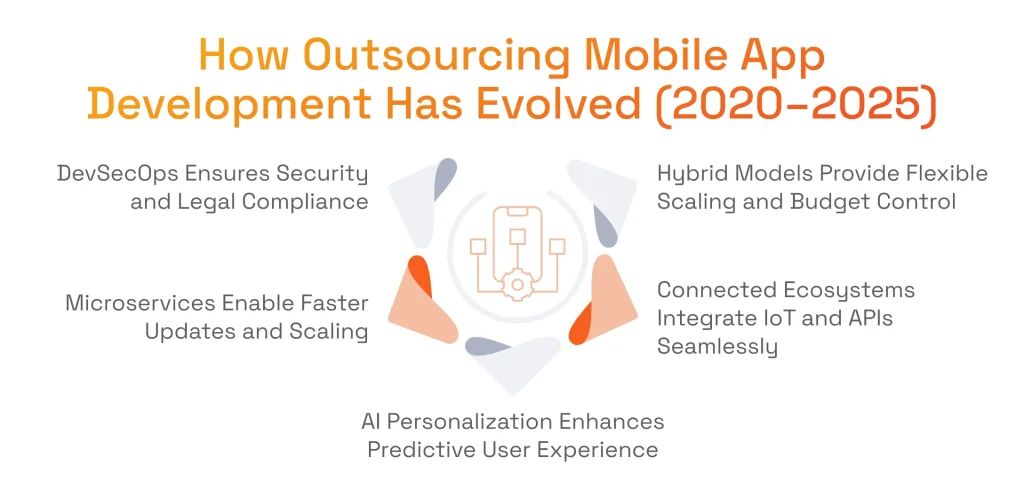
Security and Legal Compliance
When it comes to the risks of outsourcing app development, there were already specific measures in place in 2020. In 2025, it is a standard practice for outsourcing partners to embed DevSecOps practices, automated compliance checks, and continuous monitoring directly into the development pipeline. SPD Technology enhances this approach with audit trails, encryption standards, and adherence to GDPR, HIPAA, and PCI DSS, ensuring that security and legal compliance are foundational elements of our custom software development services from day one.
UX and Microservices
To support fast-paced digital demands, outsourced teams now rely heavily on microservices and modular architecture. This enables rapid feature delivery, parallel development, and smoother scalability while improving the ability to refine UX without impacting the core system. The result is a mobile product that evolves continuously and efficiently.
AI-Driven Personalization
Outsourcing has expanded into intelligence-driven innovation. Now, it is common to implement groundbreaking AI/ML features or predictive analytics functionality to deliver tailored experiences for each user. AI has become standard across many industries and is now a competitive necessity, whether you need dynamic content or a powerful smart recommendations engine.
Connected Ecosystems
Modern mobile apps need to operate in massive digital ecosystems, much more than they ever did before. Today, the standard requirements include integration with cloud platforms, numerous IoT devices, and third-party APIs. Hiring outsourcing partners will let you benefit from their expertise in creating systems that communicate reliably, ensuring uninterrupted data flow and a great user experience.
Flexible Engagement
Finally, outsourcing has embraced hybrid engagement models that allow businesses to scale teams and budgets dynamically. Combined with transparent SLAs, companies gain the flexibility and predictability needed to support continuous improvements and long-term innovation.
When to Choose Mobile App Development Outsourcing (and When Not To)
This is a critical decision that directly affects cost, speed, product quality, and long-term scalability of your solutions. Outsourcing is not for every use case, as it works best under specific conditions and can be counterproductive under others. In this section, we will discuss these scenarios and help you make a confident decision:
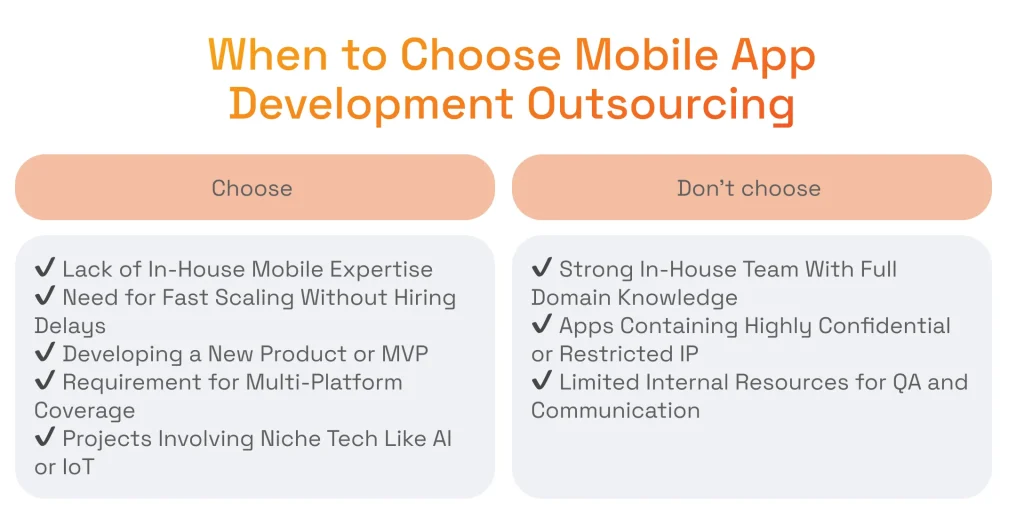
When to Outsource
- Lack of In-House Expertise: Skilled mobile engineers — especially those specializing in platform-specific development, cross-platform frameworks, or advanced technologies are difficult to hire quickly. An experienced outsourcing partner can immediately close that skill gap.
- Need to Scale Fast: Outsourced teams allow you to ramp development up or down without the long hiring cycles or fixed overhead associated with internal staffing.
- While Developing a New Product Line or MVP: Early-stage products benefit from rapid prototyping, broad technical expertise, and structured development practices that experienced vendors bring.
- Need of Multi-Platform Coverage (iOS + Android): Outsourced teams provide native specialists and cross-platform experts who can deliver consistent UX, shared codebases where appropriate, and faster parallel development.
- Requiring Niche Tech (AI, IoT, AR/VR): Outsourcing gives you access to niche experts who are difficult and expensive to hire internally and make little sense to retain when the specific project is over.
If any of these points sound familiar, choosing the right vendor will be the next step. Discover the best product development companies for your unique requirements and project specifics!
When Not to Outsource
- Having a Stable In-House Team with Full Domain Knowledge: If you already have the required experts with the necessary skills and know where to hire additional experts locally, outsourcing may introduce unnecessary complexity or duplicate capabilities.
- App Involving Highly Confidential IP or National Security Restrictions: In this case, development may need to remain entirely internal to comply with and meet data sovereignty requirements.
- Inability to Allocate Internal Resources for Communication and QA: Successful outsourcing relies on consistent collaboration; without it, even experienced vendors cannot deliver optimal results.
How to Outsource Mobile App Development — Step by Step
The best approach to outsourced mobile app development is a structured, transparent, and goal-driven process. Let’s discuss how to choose the right product development partner and achieve success in real-world scenarios with your vendor.
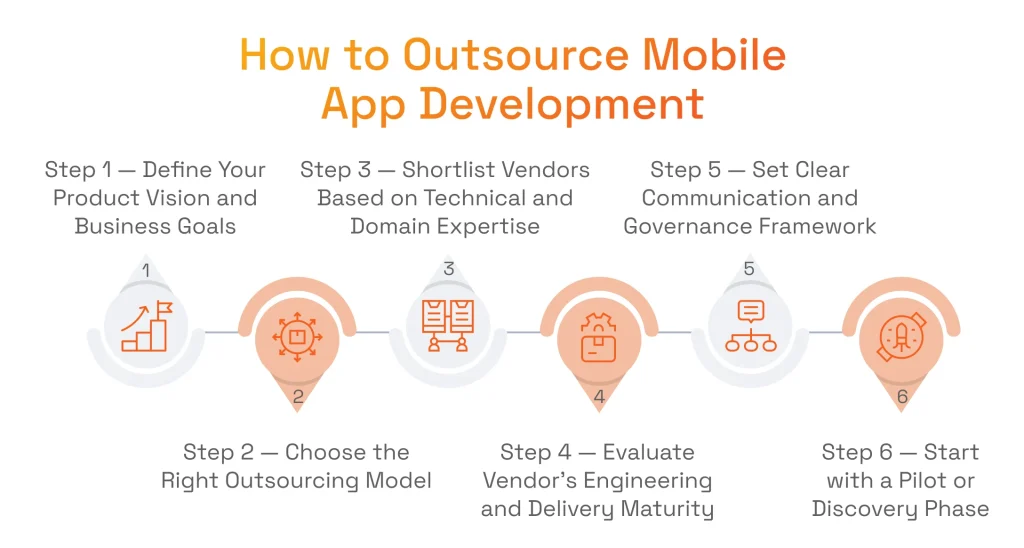
Step 1 — Define Your Product Vision and Business Goals
Before engaging any vendor, clarify all the fundamentals of your product. Determine what your target audience is, what the value proposition is, and which of the revenue models suits you best. Prioritize must-have features for your MVP to avoid unnecessary expenses at launch, and then set measurable KPIs, such as conversion or retention rates. With this clarity at the start, you will make more accurate technical decisions later.
Step 2 — Choose the Right Outsourcing Model
Your outsourcing model should align with your project’s scope, clarity, and flexibility requirements. Here are the most common options:
- Fixed Price is suitable for well-defined, stable scopes.
- Time & Material offers adaptability when features are expected to evolve.
- Dedicated Team provides long-term, scalable support for ongoing development.
There is also a possibility for hybrid models that combine these approaches, which are often ideal for teams scaling quickly post-MVP.
If you are interested in a dedicated team model, read our article on how to hire a dedicated development team and discover all the pros and cons of this approach.
Step 3 — Shortlist Vendors Based on Technical and Domain Expertise
Evaluate vendors who have built apps in industries relevant to your product. Review their portfolios to assess UI/UX quality, architectural scalability, and compliance capabilities. Ask about their experience with DevSecOps, cloud infrastructure design, and QA automation to ensure they can support enterprise-grade reliability. Writing a software development request for proposal (RFP) will also be useful at this stage.
Step 4 — Evaluate the Vendor’s Engineering and Delivery Maturity
A skilled vendor should demonstrate strong engineering discipline, from architecture design to feature improvements after a successful release. So early on, inquire about:
- CI/CD pipelines and automated deployment processes
- Test automation and code quality metrics
- Architecture reviews, peer code checks, and documentation practices
Additionally, request case studies with measurable KPIs to validate their real-world impact and delivery consistency.
Step 5 — Set a Clear Communication and Governance Framework
It is vital to establish team roles, meeting cadence, communication channels, and reporting frequency. Set clear escalation paths for risk management and leverage agile methodologies to maintain control at each iteration. It is also essential to ensure thorough knowledge transfer and obtain the rights to the code and all deliverables.
Step 6 — Start with a Pilot or Discovery Phase
The last important element of how to outsource mobile app development is to prioritize a 2–4 week discovery sprint or pilot before entering a long-term engagement. This small initial run validates the vendor’s communication style, engineering quality, and delivery predictability. It also helps finalize architecture decisions, refine requirements, and estimate the whole project scope with greater accuracy.
Key Risks in Mobile Application Development Outsourcing (and How We Mitigate Them)
Mobile apps development outsourcing offers distinctive strategic advantages for businesses; however, facing several potential risks is the price of admission. As a mobile and web development service provider, we proactively tackle every challenge, ensuring that our clients’ projects stay on track, remain aligned with business goals, and deliver significant value in the long run.
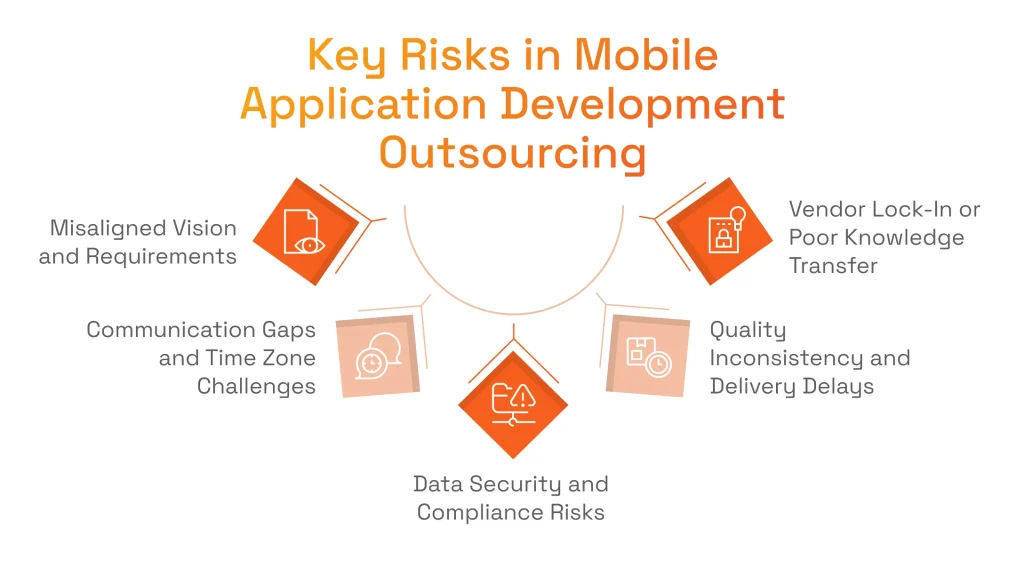
Misaligned Vision and Requirements
The first risk in mobile application development outsourcing we should discuss is the disconnect between the development team’s understanding and the client’s vision. Misunderstandings lead to rework, inflated costs, delayed releases, and ultimately a product that fails to meet user expectations.
We mitigate this by conducting thorough discovery sessions before the software product development process begins. Our experts are documenting requirements and maintaining constant alignment throughout the project. Precise specifications, user stories, and milestone reviews ensure that the product matches your expectations.
Communication Gaps and Time Zone Challenges
It is common for outsourced projects to deal with communication delays due to different time zones or collaboration styles. This may lead to severe consequences, including missed deadlines, duplicated work, or slow decision-making on critical points.
As a vetted outsourcing app development provider, we establish structured communication routines, including daily stand-ups, weekly progress reports, and real-time collaboration tools. Our teams have a proven reputation for flexibility and proactivity, ensuring that updates, decisions, and feedback flow seamlessly.
Data Security and Compliance Risks
In offshore software development, strict adherence to compliance and security protocols is mandatory when working with sensitive data. The consequences of meeting them include data breaches that carry massive regulatory fines and reputational damage.
Our mobile app outsourcing company adheres to all industry-standard security practices, including encrypted data transfer, secure coding, access controls, and regular audits. Our proven experience across FinTech, HealthTech, and enterprise domains ensures your app meets all relevant compliance standards.
Quality Inconsistency and Delivery Delays
Lack of consistency in quality and missed deadlines are almost a guarantee for a project failure, or at least wasted time and resources. To be precise, you can expect high crash rates, increased maintenance costs, user dissatisfaction, and many missed opportunities.
In our approach to outsource mobile development, we implement rigorous QA processes, automated testing, and continuous integration pipelines to maintain high quality across all releases. Our skilled project managers conduct precise sprint planning, progress tracking, and risk management to minimize delays and ensure predictable delivery.
Vendor Lock-In or Poor Knowledge Transfer
Working with an outsourcing app development team exclusively can create dependency risks. With this reliance on a single vendor, there is a threat of high switching costs, limited scalability, and limited product knowledge for your internal teams. Leveraging in-depth knowledge on how to outsource app development, we document architecture, code, and processes, while also providing training and knowledge transfer sessions. This approach ensures that our clients’ internal teams can take ownership if needed and that the project remains sustainable in the long term.
Outsourcing mobile app development is even more specific for enterprises. Read our enterprise mobile app development guide, and find out how large businesses benefit from outsourced secure application development.
Measuring Success — KPIs for Outsourced App Development Projects
In outsourced app development, success is defined by measurable outcomes that demonstrate tangible value, quality, and impact on set business goals. At SPD Technology, we emphasize complete transparency and accountability, using Key Performance Indicators (KPIs) to track progress, optimize delivery, and ensure that every project aligns with your business goals. Here are the most important ones.

Delivery Velocity
This is typically measured by the number of sprints completed per quarter and reflects how efficiently the mobile app development team converts requirements into working features. High velocity indicates that a dedicated software development team follows a streamlined process and delivers excellent results without sacrificing quality.
Defect Density and Post-Release Crash Rates
Quality is just as important as speed, if not more. Monitoring defect density and post-release crash rates ensures each release maintains high stability and reliability. Lower defect rates and minimal crashes translate into a better user experience and a stronger app reputation.
Feature Adoption and Retention Metrics
To obtain a holistic view of user engagement, leveraging feature adoption and retention tracking is a great approach. A deep understanding of which features are actively used, how often, and how long users stay engaged informs future development, UX enhancements, and update prioritization.
Infrastructure Uptime and Release Frequency
The best illustration of operational reliability is consistent release schedules and robust infrastructure. With high uptime, it’s evident that the backend architecture is stable, while a regular release frequency indicates that updates and fixes are delivered without disruption.
ROI Tracking
The best way to measure the impact of native and cross-platform mobile apps is ROI tracking. From MVP to full-blown production, it makes sense to rely on metrics, including cost per acquired user, revenue contribution, and operational efficiency gains, as they provide a clear picture of the value generated by partnering with an outsourcing mobile developer.
Oleksandr Boiko
Delivery Director at SPD Technology
“Here, at SPD Technology, we keep track of all KPIs mentioned above and more when providing outsource mobile application development services to our clients. This data-driven approach ensures that all of our projects launch successfully, perform reliably, and continue to evolve, empowering businesses to treat outsourcing as a strategic, results-driven investment.”
Real-World Proof — SPD Technology’s Expertise in Mobile App Outsourcing
Measurable, transparent results are essential for high-quality mobile software product development services. We consistently deliver reliable performance and outstanding user experiences in real projects across different industries throughout our long-term partnerships.
Our company shines in several domains, where mobile experiences matter the most. While working on FinTech, we build secure, compliant apps that handle sensitive data and large transaction volumes. We have in-depth knowledge of mobile payment app development for the world’s leading companies. Crafting healthcare solutions, we deliver regulation-ready mobile software for patient engagement, wellness support, and advanced diagnostics. In eLearning, we offer interactive learning environments of the future, while in Enterprise SaaS, our custom products streamline workflows and boost productivity.
Two of our recent projects illustrate how our app development strategy translates into tangible results. We partnered with a wellness-tech company and developed an AI-powered iOS application that uses advanced computer vision to analyze facial metrics and provide personalized recommendations. As an iPhone app development provider, we achieved 95% AI/ML model accuracy in our market-ready product and 90% accuracy in detecting facial imperfections, the product’s main functionality.
In another prominent project, we helped Seattle’s iconic Space Needle with a cross-platform mobile app and a content management system. Our distributed software development teams achieved a remarkable 2x reduction in infrastructure costs and 1,000,000+ app downloads in the first year of launch.
Conclusion — Outsourcing as a Strategic Advantage
According to Statista, the global application outsourcing market is expected to reach USD 124.20 billion by 2030. This impressive number is expected, as outsourcing mobile application development has already turned from an effective cost-saving tactic into a strategic advantage that enables companies to innovate faster, scale with confidence, and stay aligned with technologies that evolve at a lightning-fast pace. By tapping into external providers’ expertise, businesses can reduce operational complexity, accelerate delivery timelines, and ensure their mobile products are built on modern, future-ready foundations.
A competent mobile app development services provider offers much more than just writing code; it brings together technology leadership, architectural vision, and deep engineering discipline under one roof. You will be able to count on secure development practices, robust quality assurance, cloud-native scalability, and access to AI/ML development expertise.
At SPD Technology, we have made our mark in the market by building cutting-edge digital products and services aligned with our clients’ visions. Our 600+ team brings hands-on experience in every aspect of development, from early product discovery and writing a software development RFP to deployment and ongoing feature improvements. If you’re ready to accelerate your product journey with a trusted and experienced outsource mobile app development, we’re here to help.
FAQ: Outsourcing Mobile App Development
How do I choose the right outsourcing partner for my mobile app project?
The journey to choosing the right iOS and Android app development outsourcing partner starts with reviewing the vendor’s portfolio and its expertise in the required niche. It makes sense to look for companies that have delivered apps similar in scope, complexity, or technology to what you need. Check client reviews, case studies, and references to understand their reliability, communication style, and problem-solving approach.
What current technologies and trends should I consider when outsourcing a mobile app?
You should ensure the partner of your choice works with modern frameworks such as React Native, Flutter, SwiftUI, or Jetpack Compose. Next, a modern outsource mobile application development provider should be proficient in AI/ML, cloud-native architectures, and AR/VR, while preserving airtight data security.
How much does it cost to hire someone to build a mobile app?
App development cost estimation is a complex process that depends on a variety of factors, including, but not limited to:
- Project complexity
- Number of features
- Design requirements
- The amount of necessary integrations
- Location of your outsourcing partner.
Apps with minimal functionality may cost a few thousand dollars. In contrast, sophisticated projects like app development for the legal industry or eCommerce with sensitive data and automation will cost drastically more.

